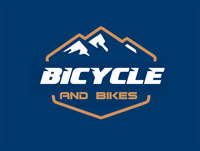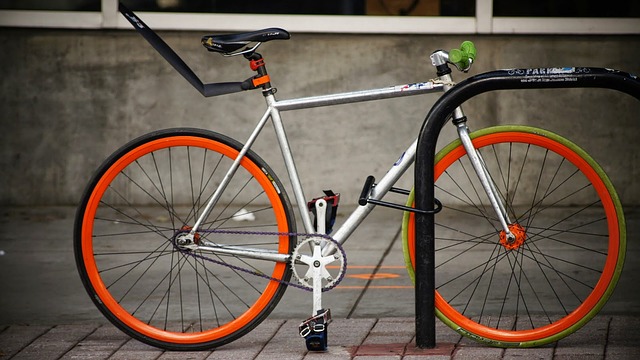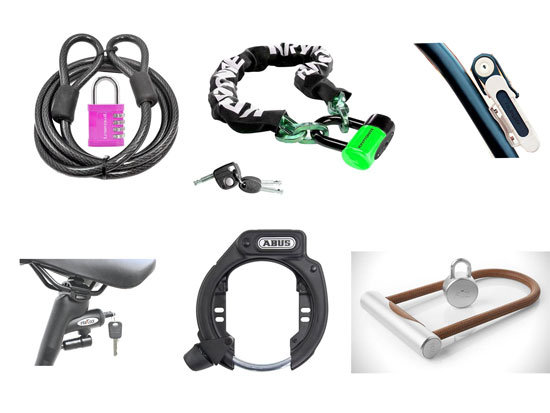Buying A Bike Lock
All the Things You Need To Consider
An Overview of What You Should Consider When Buying a Bike Lock
Welcome to our comprehensive guide on the critical factors to consider when buying a bike lock.
As you embark on the journey to find the ideal lock to secure your bicycle, it’s essential to know that not all locks are created equal!
This section provides an in-depth overview of key considerations that will guide you in making an informed decision.
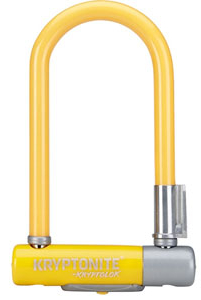 Let’s geek out, in the world of bike locks, and uncover what truly matters for your bicycle’s safety.
Let’s geek out, in the world of bike locks, and uncover what truly matters for your bicycle’s safety.
Why Do I need a Bike Lock? Selecting the Right Type of Lock for Your Cycling Needs.
What Are The Different Types Of Bicycle Locks And What Are Their Features?
Material The Lock Is Made From.
Durability & Weather Resistance
Reputable Manufacturers Of Bicycle Locks
*Plus
What’s the Difference Between a Pin Tumbler Lock, and Tubular Lock?
Important Factors To Consider When Buying a Bike Lock
Why Do I Need a Bicycle Lock?
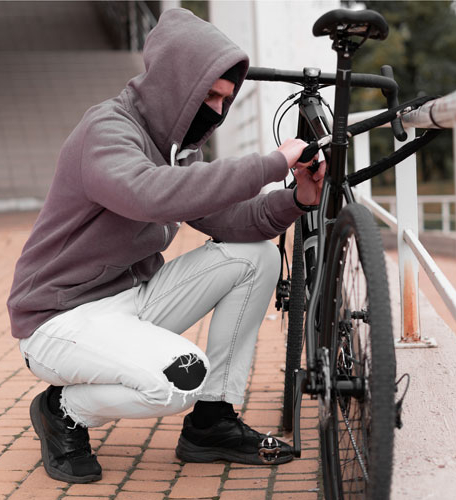
Even if you don’t expect to leave your bike unattended in public places very often, buying a bike lock is an essential step for every cyclist.
It’s important to invest in a reliable one because bike theft is unfortunately common nowadays.
This piece of equipment provides an essential layer of security for your beloved bicycle.
Here’s why:
Preventing Theft:
The primary reason for using a bicycle lock is to prevent theft. Bicycle theft is unfortunately common, with thousands of bikes stolen every year. A good lock deters thieves and makes it much more difficult for someone to just ride away with your bike.
Insurance Requirements:
If you have an insurance policy for your bike, it’s likely that one of the conditions of the policy is that an approved lock is used when leaving the bike unattended.
Securing Components:
A good lock can also be used to secure the removable components of your bike, such as the wheels and seat, in conjunction with the main frame.
Peace of Mind:
Even if you only leave your bike outside a coffee shop for a few minutes, knowing that it’s secure allows you to relax.
Increasing Recovery Chances:
Some smart locks come with additional features like tracking devices, which can help locate a bike if it is stolen.
A lock won’t make your bicycle theft-proof, but it will significantly reduce the risk. Even in low crime areas, an unlocked bike is an easy opportunity for a thief.
A good quality lock not only deters thieves but also gives you peace of mind when leaving your bicycle unattended.
With so many different types of locks available, it can be overwhelming to choose the right one, right?
Don’t worry, we’ve got you. This guide will help you make an informed decision and find a lock that suits your needs, keeping your bike safe and secure.
Selecting The Right Types of Bicycle Lock For Your Lifestyle Needs
Finding the right bike lock involves a careful assessment of your individual lifestyle, habits, and the areas where you’ll be using your bicycle. There are different types of bike locks for different situations. Before buying a bike lock, here is some food for thought…
City Cyclists & High-Risk Areas:
If your commute takes you through bustling city streets or you frequently park your bicycle in high-risk, public areas, a U-lock or D-lock is your top contender.
Renowned for their robustness, these locks are practically invincible against bolt cutters and hacksaws, providing your bicycle with the highest level of security.
For added protection in such high-risk areas, consider a frame lock. Also known as an ‘O-lock‘, a frame lock permanently attaches to your bicycle’s frame and makes the rear wheel immovable, providing an extra layer of security.
While these locks may weigh more and lack the convenience of compactness, their unrivaled security capabilities make them an excellent choice for urban riders.
Tech-Savvy Cyclists:
For those who love incorporating technology into their biking lifestyle, smart locks are an innovative choice.
Controlled via smartphone apps, these locks offer features such as tracking, tamper alerts, and even Bluetooth unlocking.
Some even have alarms that sound if the lock is tampered with, providing an extra deterrent against theft.
Quick Errands & Low-Risk Areas:
Those who cycle in areas with lower theft rates or require their bike to be unattended for only short periods might find cable locks perfectly adequate.
These locks are the epitome of convenience – they’re light, compact, and highly portable.
Additionally, their flexible nature allows you to secure your bike to a variety of structures, making them perfect for quick errands around town.
For added convenience, consider seatpost or wheel locks. These locks secure the seatpost or wheels to the bike frame, preventing thieves from quickly disassembling your bike and making off with the parts.
Comprehensive Security:
For those who desire high security but don’t want to compromise on flexibility, chain locks are an excellent option.
Particularly those made from hardened steel are tough to tamper with, and their flexible design allows you to secure your bike to larger or irregularly shaped objects.
They provide a nice middle ground between the sturdiness of U-locks and the versatility of cable locks.
Compactness & Portability:
If your priority is a compact and easily transportable lock without sacrificing too much on security, then folding locks should be on your radar.
They ingeniously fold into a small, portable size for easy transportation and can unfold into a fairly large locking device, making them a practical choice for many cyclists.
No Lock Is 100% Safe
Do bear in mind, though, that no lock is completely impervious to theft.
The objective is to make your bike as unattractive a target as possible by increasing the time and effort a thief would need to steal it.
Using a combination of locks, like a U-lock for the frame and a cable lock for the wheels, can significantly enhance your bike’s security.
Lastly, it’s a good practice to register your lock with the manufacturer, if the service is available, and always keep a record of your key number or combination.
When Buying A Bike Lock Decide on The Type That Suits Your Needs
U-locks (D-Locks)
U-locks are among the most secure bike locks available.
They consist of a large, rigid metal loop and a straight bar lock mechanism.
They are resistant to cutting and prying but their rigid shape may limit the objects you can lock your bike to.
Cable Locks
Cable bike locks are made from intertwined metal wires, typically steel, coated with plastic or rubber.
They offer flexibility, making them easy to wrap around various parts of a bike and different fixed objects.
Available types include key locks, combination locks, and smart locks.
While cable locks are lighter and more portable than other types, their security level is lower and they can be cut more easily.
Despite this, their versatility in securing multiple bike parts or fitting around large objects is a notable advantage.
Chain Locks
Chain locks are made up of steel links and offer a balance of flexibility and security.
They allow you to secure your bike to a wide variety of objects.
While they’re resistant to most attacks, their downside is that they can be heavy to carry around.
Folding Locks
Folding locks are designed with a series of metal plates linked together by rivets.
They fold up for easy portability and unfold to allow flexibility similar to chain locks.
They offer a decent level of security, but they are not as robust as U-locks or chain locks.
Smart Locks
Smart bike locks offer an elevated level of security by integrating advanced technology, which can include features such as keyless access, theft alerts, and GPS tracking, ensuring that your bicycle is safeguarded at all times.
Unlike traditional bike locks, smart locks can be controlled from your smartphone, providing convenience and remote access, enabling cyclists to lock and unlock their bicycles with just a tap on their device.
Furthermore, some smart bike locks even have a shared access feature, making them perfect for family use or bike-sharing scenarios, allowing you to grant access to multiple users through the app, revolutionizing bicycle security in the digital age.
If you have an expensive bicycle and want to protect it then buying a bike lock is a must. The smart bike lock is a great choice for tech savvy cyclists.
Wheel and Seatpost Locks
These are useful for protecting the often-targeted components of a bike: the wheels and the seatpost.
They’re not meant to replace a primary lock, but they’re convenient and add an extra layer of protection.
Frame Locks
Also known as ring locks, these are permanently attached to the bike frame, immobilizing the rear wheel.
They’re convenient and always available but only protect the bike from being ridden away, not from being carried off.
Features To Consider Carefully Before Buying a Lock
Material Strength of the Bike Lock
One of the most critical aspects of a bike lock’s security is the strength of its materials.
Look for locks made from hardened steel, as it offers exceptional resistance against cutting and sawing attempts.
High-quality locks will often specify the type of steel used and may have additional reinforcement in vulnerable areas.
Avoid buying a bike lock with thin shackles or those made of low-quality metals that can be easily compromised.
The Lock’s Design
When considering the design of a bike lock, several factors come into play. The lock’s design can influence its security, ease of use, and compatibility with different bicycle frames and structures. Here are some aspects to consider before buying a bike lock:
Shackle Design:
The design of the shackle, which is the U-shaped or chain link part of the lock, can impact both security and versatility.
Look for a shackle that is thick and made of hardened steel to resist cutting and sawing attempts.
U-locks with a smaller shackle size make it harder for thieves to insert leverage tools.
Chain locks with smaller links are more resistant to bolt cutters.
Consider the shape, size, and thickness of the shackle based on your security needs and the objects you’ll be securing your bike to.
Locking Mechanism Placement:
Consider the placement of the locking mechanism in relation to the bike frame and the position of the keyhole or dial.
The design should allow easy access to the lock, ensuring that you can comfortably insert and operate the key or combination mechanism.
A well-designed lock will provide ample clearance and be positioned in a way that avoids interfering with the bike’s frame or other components.
Frame-Friendly Design:
Ensure that the lock’s design takes into account the protection of your bike’s frame from scratches or damage.
Look for locks with rubberized or coated components that come into contact with your bike’s frame or parts. This helps prevent friction or abrasion that could mar the paint or finish of your bicycle.
Additional Features:
Some locks may have additional features designed to enhance security or user experience.
These can include anti-drill plates, anti-pick mechanisms, dust covers to protect the keyhole, or LED lights for visibility during nighttime use.
While not necessary, such features can add value and convenience to the lock’s design.
Locking Mechanism
The locking mechanism is another vital consideration when assessing the security level of a bike lock.
Look for locks with secure and robust mechanisms that provide resistance against picking, drilling, and other manipulation techniques.
Common types of reliable locking mechanisms include
- disc detainer locks,
- pin tumbler locks,
- tubular locks.
Avoid locks with cheap or flimsy mechanisms that can be easily bypassed by thieves.
To learn more in depth information about these three locking mechanisms and their differences click here.
Independent Security Ratings
To help you evaluate the security level of different bike locks, look for independent security ratings provided by organizations such as Sold Secure or ART (Stichting ART).
These organizations rigorously test and rate locks based on their resistance to various forms of attack.
Ratings are typically categorized into levels, with higher levels indicating greater security.
Consider opting for locks with high-security ratings for enhanced peace of mind.
Evaluate Feedback and Reviews
Before making a final decision, when buying a bike lock, take the time to read reviews and gather feedback from other cyclists who have used the locks you’re considering.
Real-world experiences can provide valuable insights into a lock’s reliability, durability, and actual resistance against theft attempts.
Pay attention to feedback on any reported weaknesses or vulnerabilities that may compromise the lock’s security.
Anti-Theft Features
Advanced bike locks often include additional anti-theft features to enhance their security level.
These features may include anti-drilling plates, anti-picking mechanisms, or reinforced locking mechanisms.
Some locks may also incorporate technologies such as key duplication protection or alarm systems that trigger when tampered with.
While these features may increase the cost, they can provide added security against determined thieves.
Before Buying A Bike Lock Consider Its Practicality and Portability
While security is paramount, practicality and portability are essential factors to consider.
Here are some points to keep in mind:
Size and Weight
When choosing a bike lock, consider its size and weight in relation to your specific needs.
If you often carry a backpack or have a basket or pannier on your bike, you may have more flexibility in choosing a larger, heavier lock.
However, if you prefer to travel light or have limited storage options, opt for a lock that strikes a balance between security and portability.
Look for compact and lightweight locks that are still capable of providing adequate protection for your bike.
Mounting Options
Some bike locks come with mounting brackets or pouches that allow you to attach them to your bike frame while you ride.
This feature provides convenience, as it eliminates the need to carry the lock separately in a bag.
Consider locks that offer easy and secure mounting options, as it ensures that the lock is readily accessible when you need it and reduces the chances of forgetting or misplacing it.
Ease of Use
Choose a bike lock that is user-friendly and easy to operate.
Quick and hassle-free locking and unlocking mechanisms can save you time and frustration, especially when you’re in a hurry.
Look for locks with smooth and reliable locking mechanisms that require minimal effort to secure and release.
Keyless designs or locks with easy-to-use combination dials can offer added convenience.
Flexibility and Versatility
When buying a bike lock consider the flexibility and versatility of the lock in terms of the objects and structures it can secure your bike to.
Look for locks with adequate length or reach that allow you to lock your bike to various fixed objects, such as bike racks, poles, or sturdy trees.
This flexibility ensures that you can find secure locking options wherever you go, increasing the chances of finding a suitable locking point.
Durability and Weather Resistance
Choose a lock that is durable and weather-resistant to withstand different environmental conditions.
Look for locks with coatings or materials that resist rust and corrosion, as exposure to rain or other elements can degrade the lock’s performance over time.
A durable lock will provide long-lasting security and maintain its functionality even with regular use and exposure to various weather conditions.
Consider Your Routine and Lifestyle
Take into account your daily routine and lifestyle when buying a bike lock.
If you frequently make short stops and need to lock and unlock your bike multiple times a day, a lock with a quick-release mechanism or keyless entry may be more suitable.
On the other hand, if you often leave your bike unattended for longer periods, such as during work hours or overnight, investing in a heavier, more secure lock may be a priority.
Popular Manufacturers of Bike Locks
Here’s a list of some highly recommended bicycle lock manufacturers known for producing high-quality and reliable locks:
- Kryptonite
- ABUS
- OnGuard
- Hiplok
- Master Lock
- TiGr Lock
- Blackburn
- Foldylock
- Squire
- Trelock
- Litelok
- AXA
- Onguard
- FOLDABLE LOCKS
- ABUS Bordo
- RockyMounts
- Hiplok
- Knog
- Altor
- Seatylock
These manufacturers offer a range of bike locks, including U-locks, chain locks, cable locks, and folding locks, among others.
It’s worth noting, when buying a bike lock, that the “best” bike lock for you depends on your specific needs, budget, and the level of security required in your area.
Conduct further research on the specific models offered by these manufacturers to find the lock that suits your preferences and provides the level of security you’re seeking for your bicycle.
What Are Disc Detainer Locks, Pin Tumbler Locks, And Tubular Locks?
What is a Disc Detainer Mechanism?
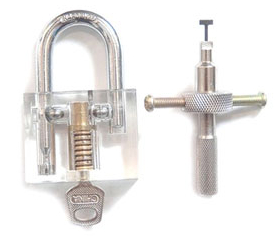 A disc detainer mechanism is a type of locking mechanism commonly used in high-security locks, including some bike locks. It provides additional resistance against picking and manipulation attempts compared to standard pin tumbler locks.
A disc detainer mechanism is a type of locking mechanism commonly used in high-security locks, including some bike locks. It provides additional resistance against picking and manipulation attempts compared to standard pin tumbler locks.
In a disc detainer mechanism, the lock consists of a series of rotating discs or plates that are arranged in a stack.
Each disc has slots or indentations around its circumference, which align to form a shear line when the correct key is inserted.
When the key is turned, the discs align perfectly, allowing the lock to open.
The unique feature of a disc detainer mechanism is that the discs are designed with false gates or irregularities, making it difficult for picking tools to accurately align all the discs to the shear line.
This design adds complexity to the picking process and increases the overall security of the lock.
Disc detainer locks often require specialized picking tools or advanced skills to manipulate successfully. T
hey offer a higher level of resistance against traditional picking techniques, such as using lock picks or bump keys. As a result, locks with disc detainer mechanisms are generally considered more secure and provide an additional layer of protection against unauthorized access.
It’s worth noting that while disc detainer mechanisms enhance security, they can also make the lock slightly more challenging to service or rekey compared to locks with simpler mechanisms.
What is a Pin Tumbler Mechanism?
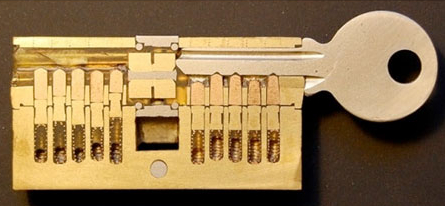 A pin tumbler lock mechanism is one of the most common types of locking mechanisms used in a wide range of applications, including bike locks.
A pin tumbler lock mechanism is one of the most common types of locking mechanisms used in a wide range of applications, including bike locks.
It consists of several spring-loaded pins of varying lengths within the lock cylinder.
Here’s how a pin tumbler lock mechanism works:
Keyway and Key Pins:
The lock cylinder contains a keyway, which is a narrow channel that accommodates the key.
Inside the keyway, there are sets of pin stacks arranged in a row. Each pin stack consists of a bottom pin and a top pin.
The bottom pin is typically shorter, while the top pin is longer.
Shear Line:
The shear line is the gap between the plug (rotating part of the lock cylinder) and the housing (stationary part of the lock).
When the correct key is inserted into the keyway, the combination of the key pins’ heights aligns the shear line perfectly.
Plugging and Unlocking:
When you insert the key into the lock, the key pins are pushed upward by the key’s ridges.
The key pins are designed to match the unique cuts and grooves on the key’s blade. As the key is turned, the key pins rise to their correct positions, aligning the shear line between the plug and the housing.
Rotation:
Once the key pins align properly at the shear line, the plug can rotate within the housing, unlocking the lock mechanism.
The rotation of the plug usually engages or disengages a locking bolt or shackle, allowing you to lock or unlock your bike.
Pin Tumbler Locks Popularity
Pin tumbler locks are popular due to their simplicity, reliability, and resistance against basic picking attempts.
Picking these locks involves manipulating each pin individually to align the shear line correctly. However, skilled individuals with lock-picking expertise can still manipulate pin tumbler locks using specialized tools or techniques.
It’s worth noting that pin tumbler locks can have different security levels based on factors such as the number of pins, the quality of materials used, and additional security features incorporated into the lock design.
Higher-security pin tumbler locks may include features like anti-drill plates, security pins, or sidebar mechanisms to increase resistance against manipulation attempts.
Overall, pin tumbler lock mechanisms are widely used in bike locks and other applications due to their effectiveness, simplicity, and long-standing track record in providing reliable security.
What is a Tubular Lock Mechanism?
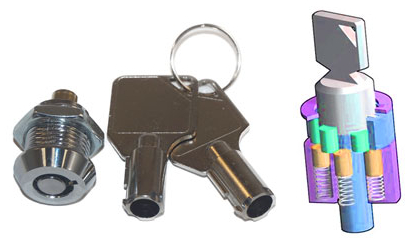 A tubular lock mechanism, also known as a pin-and-tumbler tubular lock, is a specialized type of locking mechanism commonly used in bike locks, vending machines, and some residential or commercial applications.
A tubular lock mechanism, also known as a pin-and-tumbler tubular lock, is a specialized type of locking mechanism commonly used in bike locks, vending machines, and some residential or commercial applications.
It features a cylindrical shape and utilizes a series of pins to control the locking and unlocking mechanism.
Here’s how a tubular lock mechanism works:
Keyway and Key:
The lock cylinder of a tubular lock contains a circular keyway with a series of small, spring-loaded pins arranged in a circular pattern. The key for a tubular lock has a corresponding set of grooves and notches along its edge that align with the pins inside the lock.
Key Pins:
Inside the lock cylinder, each pin stack consists of a key pin and a driver pin. The key pin is located toward the center of the lock cylinder and is shorter than the driver pin.
Shear Line:
The shear line in a tubular lock is the point at which the gap between the outer and inner cylinder aligns when the correct key is inserted. When the key is fully inserted, the notches and grooves on the key’s edge align with the key pins, creating a shear line.
Plugging and Unlocking:
As the key is inserted into the keyway, the pins are pushed upward by the key’s notches and grooves. The correct key lifts the key pins precisely to the shear line, aligning the outer and inner cylinder. This allows the lock to rotate freely.
Rotation:
Once the key pins align correctly at the shear line, the lock cylinder can rotate within the housing, unlocking the lock mechanism. The rotation typically engages or disengages a locking bolt or shackle, enabling you to secure or release your bike.
Level of Security?
Tubular locks provide a moderate level of security and are generally more resistant to basic picking attempts compared to standard pin tumbler locks.
However, they are not impervious to advanced lock-picking techniques or specialized tools designed for tubular locks.
It’s important to note that tubular lock mechanisms can have different numbers of pins, typically ranging from 6 to 8 pins, which can impact the lock’s security level.
Higher-security tubular locks may include additional features such as anti-drill components, security pins, or specialized sidebar mechanisms to enhance resistance against manipulation attempts.
In summary, tubular lock mechanisms are cylindrical in shape and employ pins and grooves in a circular pattern to control the locking and unlocking mechanism. They are commonly used in bike locks and other applications where compact and durable locking mechanisms are desired.
What’s the Difference Between a Pin Tumbler Lock, and Tubular Lock?
Pin Tumbler Locks and Tubular Locks are two distinct types of locking mechanisms with some key differences:
Design and Shape
Pin Tumbler Locks:
Pin tumbler locks have a traditional, elongated cylinder shape.
They feature a series of spring-loaded pins arranged in a row, with the keyway running along the length of the lock.
Tubular Locks:
Tubular locks, on the other hand, have a cylindrical shape.
They utilize a circular keyway with pins arranged in a circular pattern within the lock cylinder.
Key and Keyway
Pin Tumbler Locks
Pin tumbler locks use a flat key with cuts and grooves along its edge.
The key is inserted into the keyway, and the pins align along a straight shear line when the correct key is used.
Tubular Locks
Tubular locks require a tubular key with notches and grooves around its circumference.
The key is inserted into the circular keyway, and the pins align along a circular shear line when the correct key is used.
Number and Configuration of Pins
Pin Tumbler Locks:
Pin tumbler locks typically have multiple pin stacks arranged in a row within the lock cylinder.
Each pin stack consists of a key pin and a driver pin, and they align at the shear line when the correct key is inserted.
Tubular Locks:
Tubular locks usually have a single pin stack composed of a key pin and a driver pin for each pin chamber around the circular keyway.
The number of pins can vary, commonly ranging from 6 to 8, depending on the lock.
Resistance to Picking
Pin Tumbler Locks:
Pin tumbler locks have been extensively studied and picked over the years, making them more susceptible to picking attempts. However, higher-security pin tumbler locks with security features can still provide effective resistance against manipulation.
Tubular Locks:
Tubular locks offer a moderate level of resistance against picking attempts due to their unique circular pin configuration.
Their less common design and circular keyway make them less susceptible to standard lock-picking techniques.
However, advanced lock-picking tools specifically designed for tubular locks do exist.
In Summary
Both pin tumbler locks and tubular locks have their strengths and weaknesses, and their suitability depends on the specific application and security requirements.
Pin tumbler locks are more commonly found in various lock types, including bike locks, padlocks, and door locks.
Tubular locks are often used in applications where compact design and resistance to manipulation are desired, such as bike locks and vending machines.
